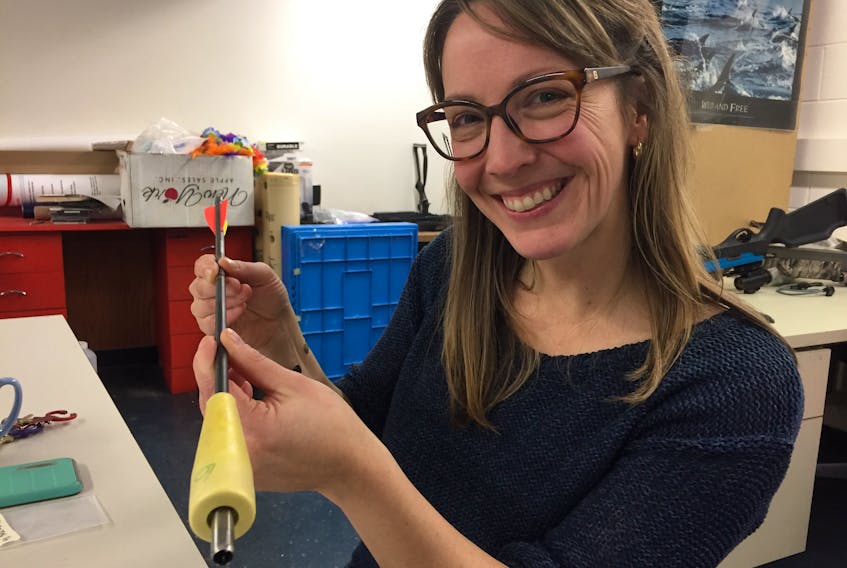A northern bottlenose whale researcher has found another reason to fear for the future of the endangered population.
Laura Feyrer, a PhD candidate in Dalhousie University’s marine biology department, has concluded these reclusive whales with bulbous foreheads may feed from their mothers for up to four years.
“We assume that while they’re nursing, (females adults) are not going to become pregnant again,” Feyrer said in a recent interview.

“So this has its impact in that they’re not able to reproduce for that four-year period. So that extends their reproductive cycle and reduces the number of babies that any female could have, which means their population is likely to grow much, much slower than previously estimated.”
Previous estimates had young bottlenoses feeding for about a year.
Feyrer and fellow researcher Shu ting Zhao came up with the longer feeding period by analyzing the teeth of bottlenose dolphins.
They used a very rare collection of teeth that were taken by whalers in Iceland and Labrador in the 1960s and 1970s.
A male bottlenose usually has two teeth, which aren’t typical teeth but rather represent a sexual characteristic of the male.
“These tiny little nubs that stick out only in the mature males,” Feyrer explained. “In the females it’s deeply embedded in the jaws. They’re not for feeding or eating.”
After cutting their sample tooth in half, she and Zhao analyzed the chemical composition of particular layers in the tooth.
“What’s interesting about whale teeth is that every year the animal is alive, they lay down a growth layer inside of the tooth,” Feyrer explained. “So it’s kind of like a tree ring and what’s deposited in the tooth is a record of the chemical composition of their tissues (and) a record of what they ate in that year.”
The researchers were able to narrow their analysis to each year the animal was alive.
“We took those samples and we ran them through what’s called stable isotope analysis and that gave us information about their diet and their changing diet over the first five years of their life and then as well when they were adults,” she said, which was how they came to the four-year feeding conclusion.

Only about 150 northern bottlenoses make up the population that lives off Nova Scotia (another group has been identified that lives in the northern Labrador/Iceland region).
Northern bottlenoses are one of the “beaked whale” deep-diving species that live far offshore. The Nova Scotia population is usually found in the “Gully” marine protected area about 200 kilometres off the province near Sable Island.
These whales are known to dive up to 1,400 metres, often right down to the Gully sea bottom, in search of food such as squid and bottom-dwelling fish. In comparison, a humpback whale would only go as deep as 200 metres.
It’s possible that the long period of “maternal investment” that her most recent study has uncovered is related to that deep-diving lifestyle.
Although much remains mysterious about the northern bottlenecks’ group and social behaviour, it stands to reason that it takes a long time for a mother to teach her calf feeding techniques that take them so far down into the ocean, Feyrer said.
In previous research, she determined that the population has a shallow genetic base, which also raises risks for the future viability of the small population.
Combined with the long feeding period, “it just adds another layer of their vulnerability” if the whales experienced a mass-stranding or disease event.
The latest study, called “Prolonged maternal investment in northern bottlenose whales alters our understanding of beaked whale reproductive life history,” has been published in the journal PLOS ONE.
Feyrer said the northern bottlenose has made for a fascinating subject for her doctoral studies.
“They’re a really enigmatic and charismatic animal and getting to spend time with them is just you know definitely been the highlight of my work,” said Feyrer, who credited Zhao, whale researcher Corey Matthews who works in DFO’s Arctic division and her primary supervisor Ha lWhitehead for their contributions to her research.
“I love being on the water and I love studying mysteries and this species of whale, they’re very good at giving me the carrot, so I get to go out in a boat and I get to spend time with them and observe them. I get that little bit of data and I have to put all the pieces together and try and understand what it is that’s going on with them and how we can best help them.”









